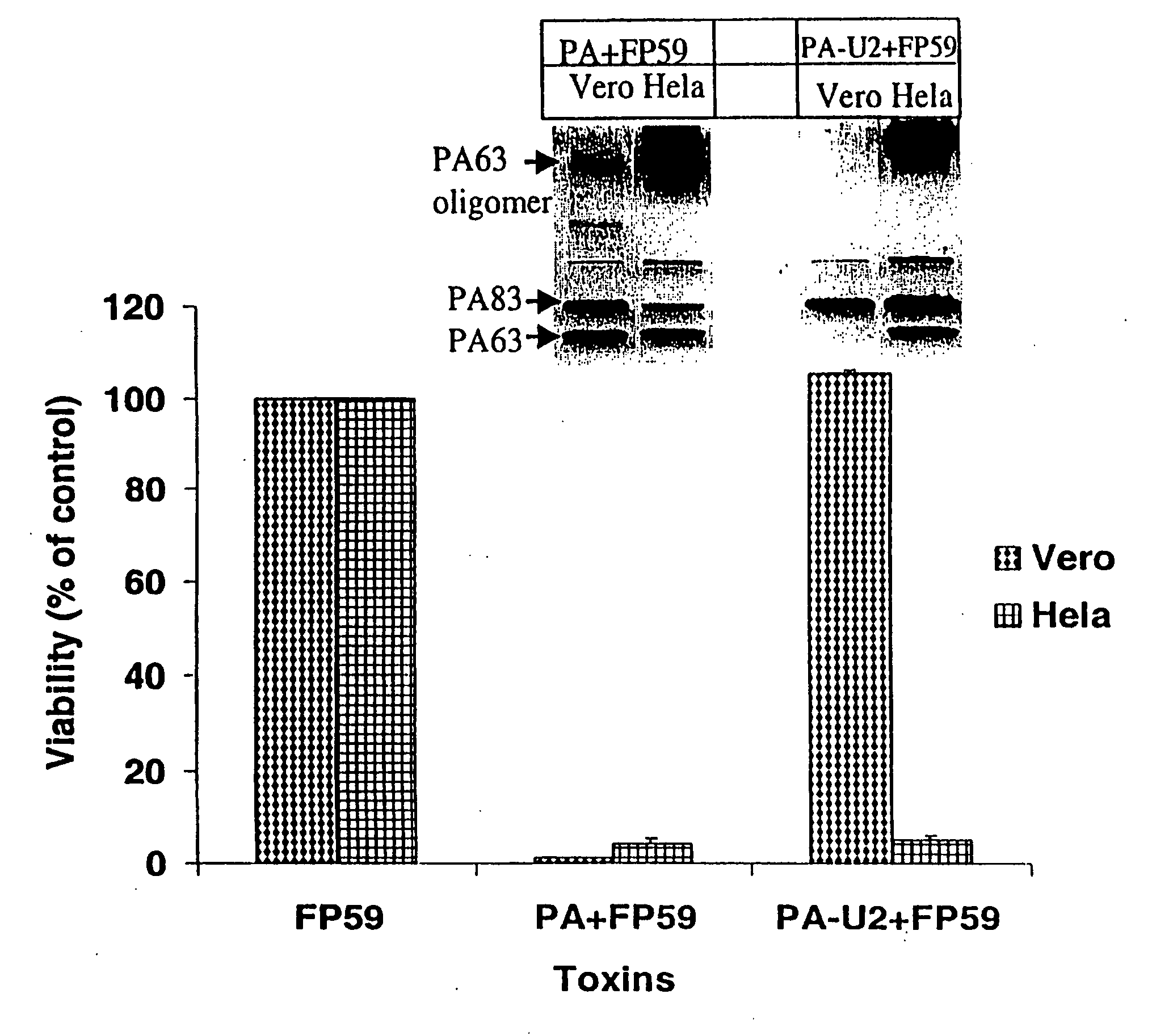Mutated anthrax toxin protective antigen proteins that specifically target cells containing high amounts of cell-surface metalloproteinases or plasminogen activator receptors
a technology of anthrax and protective antigens, applied in the field of mutated anthrax toxin protective antigen proteins, can solve the problems of poorly understood mechanisms
- Summary
- Abstract
- Description
- Claims
- Application Information
AI Technical Summary
Benefits of technology
Problems solved by technology
Method used
Image
Examples
examples
[0129]The following examples are provided by way of illustration only and not by way of limitation. Those of skill in the art will readily recognize a variety of noncritical parameters that could be changed or modified to yield essentially similar results.
example i
Construction of Mutant PA with Matrix Metalloproteinase Cleavage Sites
[0130]A. Materials
[0131]Enzymes for DNA manipulation and modification were purchased from New England Biolabs (Beverly, Mass.). FP59 and soluble form furin were prepared in our laboratory according to standard methodology. Active MMP-2 was a kind gift from Dr. William Stetler-Stevenson, active form MMP-9 was purchased from CALBIOCHEM (San Diego, Calif.). MMP inhibitors BB-94 (Batimastat) and BB-2516 (Marimastat) were kind gifts from British Biotechnology Limited, GM6001 was a kind gift from Dr. Richard E. Galardy prepared as described (Grobelny, D., et al., Biochemistry, 31:7152-7154. (1992)). Rabbit anti-PA polyclonal antibody (#5308) was made in our laboratory. Rabbit anti-MT-MMP1 (AB815) was purchased from CHEMICON International, Inc. (Temecula, Calif.). The sequence for LF can be found, e.g., in Robertson & Leppla, Gene 44: 71-78 (1986). The sequence for PA is described, e.g., in Singh et al., J. Biol. Chem. 2...
example ii
Construction of Mutant PA with Matrix Metalloproteinase Cleavage Sites
[0164]Mutant PA proteins were constructed and tested as described in Example I, substituting one of the following plasminogen activator cleavage sites of Table 2 for the MMP cleavage sites described above. Phage display libraries were used to identify sequences having specificity for a particular protease (see, e.g., Coombs et al., J. Biol. Chem. 273:4323-4328 (1998); Ke et al., J. Biol. Chem. 272:20456-20462 (1997); Ke et al., J. Biol. Chem. 272:16603-16609 (1997)). These libraries can be used by one of skill in the art to select sequences specifically recognized by MPP and plasminogen activator proteases.
TABLE 2u-TP and t-PA cleavage sitesu-PAt-PAa-PA:t-PASubstrate sequenceKcat / KmKcat / KmselectivityPCPGRVVGG0.880.293.0PGSGRSA12006020PGSGKSA1931.6121PQRGRSA458500.005
PUM
| Property | Measurement | Unit |
|---|---|---|
| concentrations | aaaaa | aaaaa |
| concentrations | aaaaa | aaaaa |
| concentration | aaaaa | aaaaa |
Abstract
Description
Claims
Application Information
 Login to View More
Login to View More - R&D
- Intellectual Property
- Life Sciences
- Materials
- Tech Scout
- Unparalleled Data Quality
- Higher Quality Content
- 60% Fewer Hallucinations
Browse by: Latest US Patents, China's latest patents, Technical Efficacy Thesaurus, Application Domain, Technology Topic, Popular Technical Reports.
© 2025 PatSnap. All rights reserved.Legal|Privacy policy|Modern Slavery Act Transparency Statement|Sitemap|About US| Contact US: help@patsnap.com



